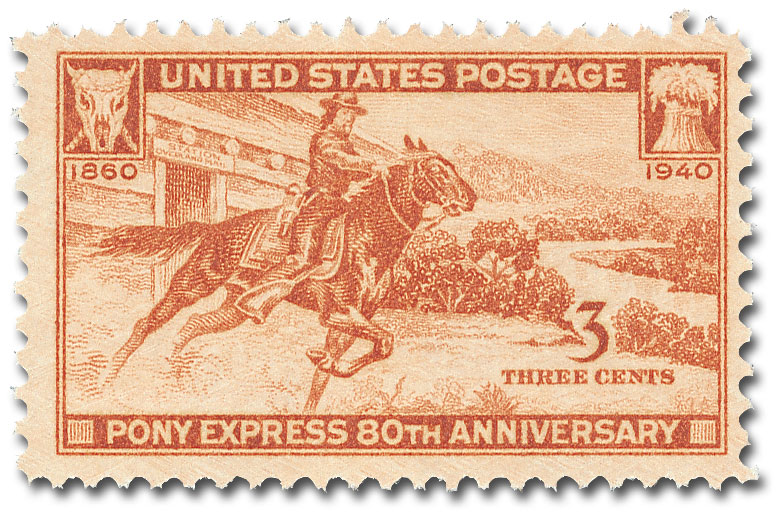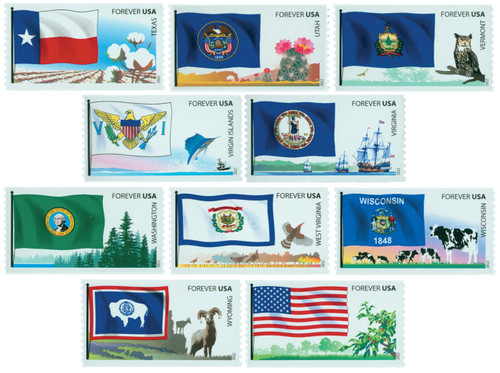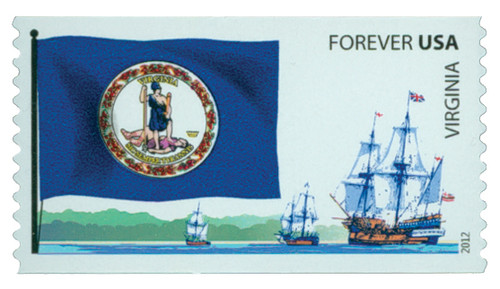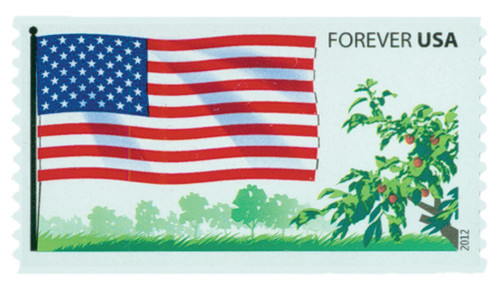
# 4324 - 2012 First-Class Forever Stamp - Flags of Our Nation: Utah
U.S. #4324
2012 45¢ Utah
Flags of Our NationÂ
Â
Issue Date: August 16, 2012
City: Sacramento, CA
Quantity: 25,000,000
Printed By: American Packaging Corp for Sennett Security Products
Printing Method: Photogravure
Color: Multicolored
Â
Brigham Young Establishes Mormon Homeland in Salt Lake City, Utah
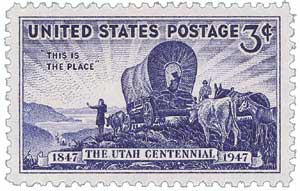
After 17 months of travel searching for a new home for his persecuted people, Brigham Young found Utah’s Great Salt Lake Valley on July 24, 1847 and proclaimed, “This is the place†(as pictured on U.S. #950).
The Church of Jesus Christ of Latter-day Saints was founded in 1830 when Joseph Smith published the Book of Mormon. The religion grew fast in his New York community and spread to Ohio, Missouri, and Illinois. However, it included controversial practices, including polygamy, which made its followers targets of mob violence.
Following Smith’s death, Brigham Young became the church’s new leader and vowed to find a new home for all of his fellow Mormons, in “a place on this earth that nobody else wants.†He led a convoy of more than 10,000 followers and set up camp in Iowa. Young then took a smaller detachment of 148 people across the Rocky Mountains. As soon as he reached Utah’s Great Salt Lake Valley, he knew it was his people’s future home.
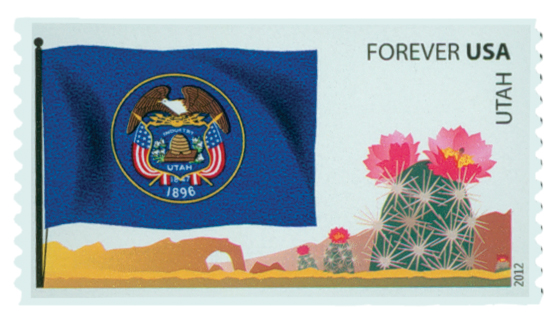
These devout settlers called the region Deseret, after the Mormon word for honeybee. The honeybee is an important symbol of hard work and industry for the Mormons. Many people still refer to Utah as Deseret, and Utah’s nickname is the Beehive State.
In 1849, the Mormons established the Perpetual Emigrating Fund. This fund helped Mormons move to Utah. It operated for about 40 years and attracted about 50,000 Mormons to Utah. These people came from other areas of the United States as well as Denmark, England, Norway, Scotland, Sweden, and Wales.
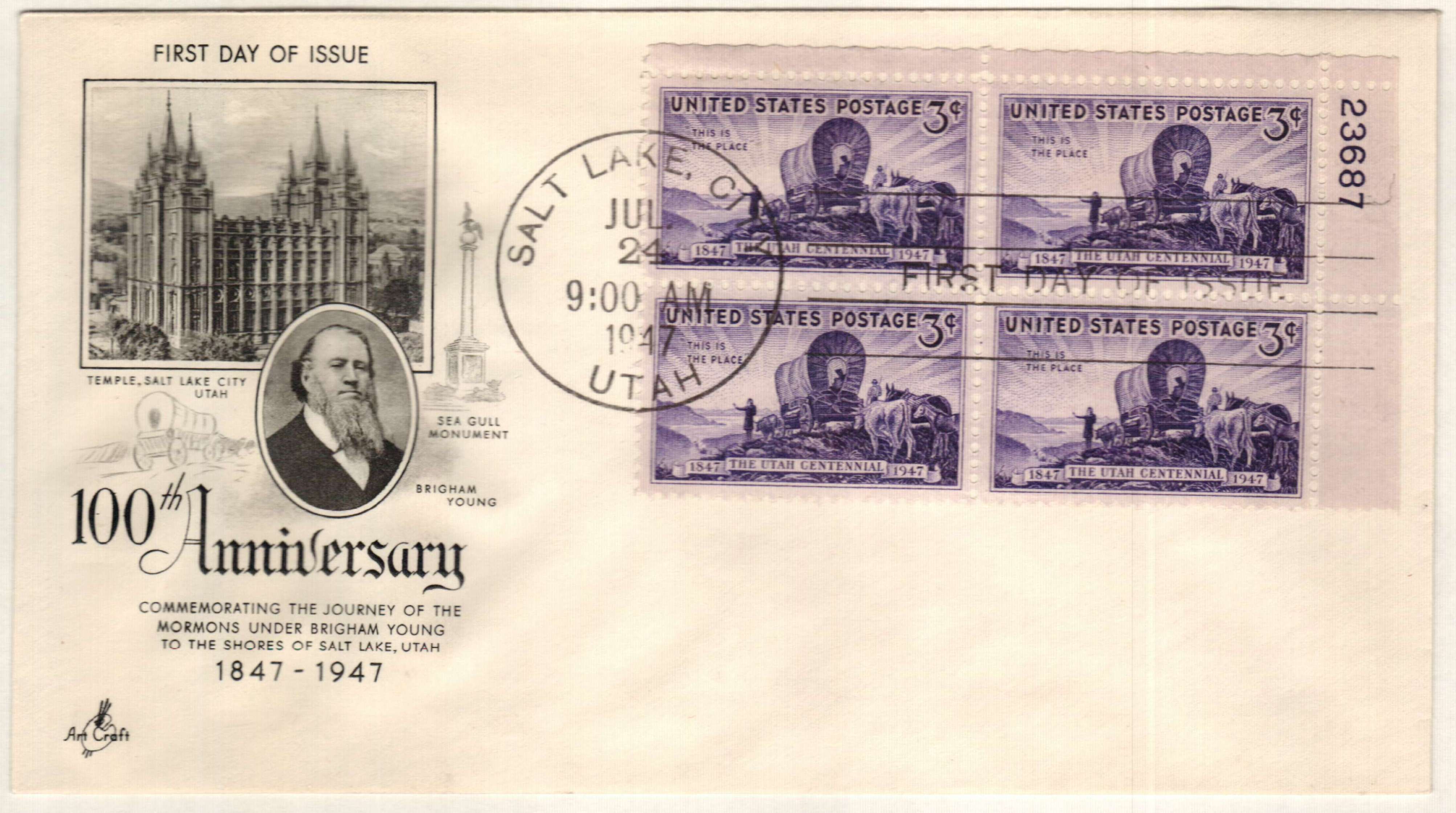
When the Mormons first arrived in Utah, the area officially belonged to Mexico. However, at that time the U.S. and Mexico were fighting the Mexican War, which lasted from 1846-1848. When the U.S. won the war, it acquired a great deal of land, including Utah.
The Mormons established the State of Deseret in 1849, with a temporary government led by Brigham Young. A constitution was adopted, and the settlers asked to be admitted to the Union. However, Congress was embroiled in great debates about slavery at the time. But with the Compromise of 1850, the Utah Territory was established.
Between 1849 and 1895, Utah tried to join the Union several times. Congress refused because of an uncommon Mormon practice called polygamy – specifically, a form where a man had more than one wife which they referred to as “plural marriage.†Few Mormons actually practiced polygamy. But as long as the Mormons allowed it, Utah was denied statehood.
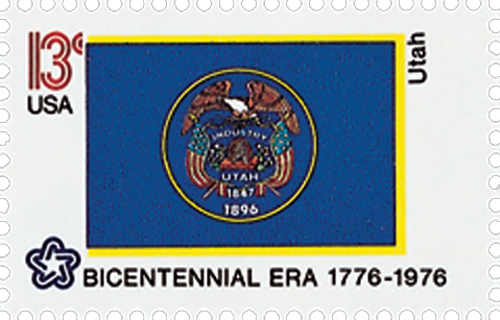
The Federal government began enforcing the laws against polygamy during the 1880s. About 1,000 Mormons were fined or sent to prison. In 1887, a law was passed allowing the Federal government to seize church property for use by public schools. In 1890, the church began discouraging polygamy, and by 1904 it was prohibited.
In 1895, Utah submitted a new constitution to Congress. This constitution outlawed polygamy and protected the government from church domination. As a result, Utah achieved statehood on January 4, 1896.
In 1860, mail contractor Ben Holladay joined forces with the Russell, Majors and Waddell Freight Company to create a mail-carrying company that would be faster and more efficient than the stagecoaches of the Butterfield Overland Mail. Holladay established 200 stations 25 miles apart along a 1,900-mile trail from St. Joseph, Missouri, to Sacramento, California.
Holladay then put a call out for small, brave young men that could ride a horse well. He bought 500 of the fastest horses he could find and hired 80 daring riders. The first rider left St. Joseph, Missouri, on April 3, 1860. The route followed the Oregon and California Trails to Fort Bridger in Wyoming, the Mormon Trail to Salt Lake City, the Central Nevada Route to Carson City, Nevada, and over the Sierra to Sacramento, California. The first rider reached Salt Lake City at 6:45 p.m. on April 9 before arriving in Sacramento around midnight on April 14, 1860. In the mochilla (a special saddlebag for mail) was a message of congratulations from President Buchanan to the Governor of California, which had been telegraphed from Washington to St. Joseph.
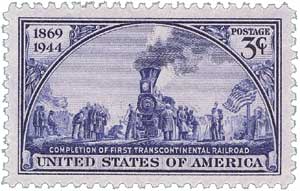
The adventurous service came to an end just 18 months after that first ride. On October 24, 1861, the Western Union Telegraph Company completed the first transcontinental telegraph line in Salt Lake City. This accomplishment ushered in a new age of communications in the U.S.
Â
Â
Flags of Our Nation, Set VI: 2012 marks the sixth and final set of stamps in the series. The state and territory flags reflect the history of each region they represent. The uniqueness of each state flag in the series reflects the diversity of the United States and its territories.  Â
Â
The symbols of Utah’s flag indicate the patriotism and work ethic of the original pioneers who made their homes there. Â
Â
Mormon leader Brigham Young encouraged his followers to show allegiance to the United States by instructing them to “unfurl the Stars and Stripes.â€Â Patriotism is still strong in Utah, and two U.S. flags and an American eagle are now featured on the state seal in the center of the flag. Â
Â
Other aspects of the flag reflect Utah’s founding. The Latter-day Saints arrived in the unsettled southwest in 1847. They named the territory Deseret, meaning honeybee, according to the Book of Mormon. The beehive symbolized the ideals of hard work and self-reliance, which were needed to tame the harsh land. Â
Â
The territory became the state of Utah in 1896. Though named for the Ute Indians, the Mormons’ beehive was incorporated into the state’s seal. Â
Â
Utah was still without an official flag when the Sons and Daughters of Utah Pioneers presented a banner to the battleship USS Utah. It displayed the state seal, surrounded by a gold circle on a blue field. This flag was so well-liked, it became the official symbol of Utah in 1913.
U.S. #4324
2012 45¢ Utah
Flags of Our NationÂ
Â
Issue Date: August 16, 2012
City: Sacramento, CA
Quantity: 25,000,000
Printed By: American Packaging Corp for Sennett Security Products
Printing Method: Photogravure
Color: Multicolored
Â
Brigham Young Establishes Mormon Homeland in Salt Lake City, Utah

After 17 months of travel searching for a new home for his persecuted people, Brigham Young found Utah’s Great Salt Lake Valley on July 24, 1847 and proclaimed, “This is the place†(as pictured on U.S. #950).
The Church of Jesus Christ of Latter-day Saints was founded in 1830 when Joseph Smith published the Book of Mormon. The religion grew fast in his New York community and spread to Ohio, Missouri, and Illinois. However, it included controversial practices, including polygamy, which made its followers targets of mob violence.
Following Smith’s death, Brigham Young became the church’s new leader and vowed to find a new home for all of his fellow Mormons, in “a place on this earth that nobody else wants.†He led a convoy of more than 10,000 followers and set up camp in Iowa. Young then took a smaller detachment of 148 people across the Rocky Mountains. As soon as he reached Utah’s Great Salt Lake Valley, he knew it was his people’s future home.

These devout settlers called the region Deseret, after the Mormon word for honeybee. The honeybee is an important symbol of hard work and industry for the Mormons. Many people still refer to Utah as Deseret, and Utah’s nickname is the Beehive State.
In 1849, the Mormons established the Perpetual Emigrating Fund. This fund helped Mormons move to Utah. It operated for about 40 years and attracted about 50,000 Mormons to Utah. These people came from other areas of the United States as well as Denmark, England, Norway, Scotland, Sweden, and Wales.

When the Mormons first arrived in Utah, the area officially belonged to Mexico. However, at that time the U.S. and Mexico were fighting the Mexican War, which lasted from 1846-1848. When the U.S. won the war, it acquired a great deal of land, including Utah.
The Mormons established the State of Deseret in 1849, with a temporary government led by Brigham Young. A constitution was adopted, and the settlers asked to be admitted to the Union. However, Congress was embroiled in great debates about slavery at the time. But with the Compromise of 1850, the Utah Territory was established.
Between 1849 and 1895, Utah tried to join the Union several times. Congress refused because of an uncommon Mormon practice called polygamy – specifically, a form where a man had more than one wife which they referred to as “plural marriage.†Few Mormons actually practiced polygamy. But as long as the Mormons allowed it, Utah was denied statehood.

The Federal government began enforcing the laws against polygamy during the 1880s. About 1,000 Mormons were fined or sent to prison. In 1887, a law was passed allowing the Federal government to seize church property for use by public schools. In 1890, the church began discouraging polygamy, and by 1904 it was prohibited.
In 1895, Utah submitted a new constitution to Congress. This constitution outlawed polygamy and protected the government from church domination. As a result, Utah achieved statehood on January 4, 1896.
In 1860, mail contractor Ben Holladay joined forces with the Russell, Majors and Waddell Freight Company to create a mail-carrying company that would be faster and more efficient than the stagecoaches of the Butterfield Overland Mail. Holladay established 200 stations 25 miles apart along a 1,900-mile trail from St. Joseph, Missouri, to Sacramento, California.
Holladay then put a call out for small, brave young men that could ride a horse well. He bought 500 of the fastest horses he could find and hired 80 daring riders. The first rider left St. Joseph, Missouri, on April 3, 1860. The route followed the Oregon and California Trails to Fort Bridger in Wyoming, the Mormon Trail to Salt Lake City, the Central Nevada Route to Carson City, Nevada, and over the Sierra to Sacramento, California. The first rider reached Salt Lake City at 6:45 p.m. on April 9 before arriving in Sacramento around midnight on April 14, 1860. In the mochilla (a special saddlebag for mail) was a message of congratulations from President Buchanan to the Governor of California, which had been telegraphed from Washington to St. Joseph.

The adventurous service came to an end just 18 months after that first ride. On October 24, 1861, the Western Union Telegraph Company completed the first transcontinental telegraph line in Salt Lake City. This accomplishment ushered in a new age of communications in the U.S.
Â
Â
Flags of Our Nation, Set VI: 2012 marks the sixth and final set of stamps in the series. The state and territory flags reflect the history of each region they represent. The uniqueness of each state flag in the series reflects the diversity of the United States and its territories.  Â
Â
The symbols of Utah’s flag indicate the patriotism and work ethic of the original pioneers who made their homes there. Â
Â
Mormon leader Brigham Young encouraged his followers to show allegiance to the United States by instructing them to “unfurl the Stars and Stripes.â€Â Patriotism is still strong in Utah, and two U.S. flags and an American eagle are now featured on the state seal in the center of the flag. Â
Â
Other aspects of the flag reflect Utah’s founding. The Latter-day Saints arrived in the unsettled southwest in 1847. They named the territory Deseret, meaning honeybee, according to the Book of Mormon. The beehive symbolized the ideals of hard work and self-reliance, which were needed to tame the harsh land. Â
Â
The territory became the state of Utah in 1896. Though named for the Ute Indians, the Mormons’ beehive was incorporated into the state’s seal. Â
Â
Utah was still without an official flag when the Sons and Daughters of Utah Pioneers presented a banner to the battleship USS Utah. It displayed the state seal, surrounded by a gold circle on a blue field. This flag was so well-liked, it became the official symbol of Utah in 1913.






